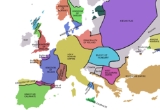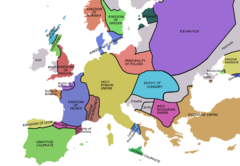
Svetoslav Suronja
Encyclopedia

Kingdom of Croatia (medieval)
The Kingdom of Croatia , also known as the Kingdom of the Croats , was a medieval kingdom covering most of what is today Croatia and Bosnia and Herzegovina in the Balkans.Established in 925, it ruled as a sovereign state for almost two centuries...
from 997 to 1000. He was a member of House of Trpimirović. He reigned with the help of his Ban
Ban (title)
Ban was a title used in several states in central and south-eastern Europe between the 7th century and the 20th century.-Etymology:The word ban has entered the English language probably as a borrowing from South Slavic ban, meaning "lord, master; ruler". The Slavic word is probably borrowed from...
, Varda. His name was Svetoslav, but because of his physiology and, probably, his temper, he was nicknamed Suronja which could be translated as dark man or cold man. He was the oldest son of king Stjepan Držislav
Stjepan Držislav
Stephen Držislav was a King of Croatia from 969 AD until his death in 997. He was a member of the Trpimirović dynasty. He ruled from Biograd with Godemir as his Ban.-Early period:...
. His father had given him the title of Duke
Duke
A duke or duchess is a member of the nobility, historically of highest rank below the monarch, and historically controlling a duchy...
and designated Svetoslav as his successor. He reigned with his ban Varda.
Rebellion
After death of their father, his brothers KrešimirKrešimir III of Croatia
Krešimir III was a King of Croatia in 1000–1030 from the House of Trpimirović and founder of its cadet line House of Krešimirović. He was the middle son of former King Stjepan Držislav. Until 1020, he co-ruled with his brother Gojslav.-Reign:...
and Gojslav
Gojslav of Croatia
Gojslav was a monarch who co-ruled the Kingdom of Croatia with his brother Krešimir III from 1000 to his death in 1020. He was the youngest son of the former Croatian King Stjepan Držislav and a member of royal House of Trpimirović.- Revolt and reign :...
started organizing a rebellion against him since Svetoslav rejected sharing power over the kingdom. The brothers had asked Bulgarian emperor Samuil
Samuil of Bulgaria
Samuel was the Emperor of the First Bulgarian Empire from 997 to 6 October 1014. From 980 to 997, he was a general under Roman I of Bulgaria, the second surviving son of Emperor Peter I of Bulgaria, and co-ruled with him, as Roman bestowed upon him the command of the army and the effective royal...
for aid, even though the emperor was at war with the Byzantine Empire
Byzantine Empire
The Byzantine Empire was the Eastern Roman Empire during the periods of Late Antiquity and the Middle Ages, centred on the capital of Constantinople. Known simply as the Roman Empire or Romania to its inhabitants and neighbours, the Empire was the direct continuation of the Ancient Roman State...
. In the war, the Byzantines were supported by Venice
Republic of Venice
The Republic of Venice or Venetian Republic was a state originating from the city of Venice in Northeastern Italy. It existed for over a millennium, from the late 7th century until 1797. It was formally known as the Most Serene Republic of Venice and is often referred to as La Serenissima, in...
and Svetoslav Suronja, who had continued his father's policy. Samuil had accepted the revolters' invitation and attacked Croatia in 998, which started the last of three Croatian-Bulgarian wars
Croatian-Bulgarian wars
The Croatian-Bulgarian Wars were a series of conflicts that erupted three times during the 9th and 10th centuries between the medieval realms of Croatia and Bulgaria...
. In his rampage, he took all of Croatian Dalmatia up to Zadar after which he ended his rampage, returning home to Bulgaria through Bosnia. Samuil gave all the territory he took to the revolters Krešimir
Krešimir III of Croatia
Krešimir III was a King of Croatia in 1000–1030 from the House of Trpimirović and founder of its cadet line House of Krešimirović. He was the middle son of former King Stjepan Držislav. Until 1020, he co-ruled with his brother Gojslav.-Reign:...
and Gojslav
Gojslav of Croatia
Gojslav was a monarch who co-ruled the Kingdom of Croatia with his brother Krešimir III from 1000 to his death in 1020. He was the youngest son of the former Croatian King Stjepan Držislav and a member of royal House of Trpimirović.- Revolt and reign :...
. Using this newly-gained territory and further Bulgarian aid, the brothers overthrew their elder brother, Svetoslav Suronja, and became rulers of Croatia.
War with Venice
Svetoslav's reign was particularly unpleasant for the Dalmatian cities, as they were occasionally raided and pillaged by his supporters. The cities asked the Venetian Republic for help in autumn of 999, which encouraged Venice to make a pact with the Byzantine Empire in order to secure the cities for themselves. Using events like the casus belli, the Venetian Doge Pietro II OrseoloPietro II Orseolo
Pietro II Orseolo was the Doge of Venice from 991 to 1009.He began the period of eastern expansion of Venice that lasted for the better part of 500 years...
launched a campaign in Dalmatia against Croatia in 1000.
During May, Croatia lost the islands Cres
Cres
Cres is an Adriatic island in Croatia. It is one of the northern island in the Kvarner Gulf and can be reached via ferry from the island Krk or from the Istrian peninsula ....
, Lošinj
Lošinj
Lošinj is a Croatian island in the northern Adriatic Sea, in the Kvarner Gulf. It is almost due south of the city of Rijeka and part of the Primorje-Gorski Kotar county....
, Krk
Krk
Krk is a Croatian island in the northern Adriatic Sea, located near Rijeka in the Bay of Kvarner and part of the Primorje-Gorski Kotar county....
and Rab
Rab
Rab is an island in Croatia and a town of the same name located just off the northern Croatian coast in the Adriatic Sea.The island is long, has an area of and 9,480 inhabitants . The highest peak is Kamenjak at 408 meters...
to the Doge, who was eventually received in Zadar and recognised as its master. Svetoslav sent envoys to the city offering peace, but the Doge declined and decided to further his campaign. From here the island Pašman
Pašman
Pašman is an island off the coast of the Adriatic Sea in Croatia, located to the south of Zadar, surrounded by the islands Ugljan, Iž, Dugi otok and Kornati...
was taken and, with negotiations, the city of Biograd.
Svetoslav's descendant, Dmitar Zvonimir, will later become the Croatian king in 1074.
Sources
- Intervju - ДИНАСТИЈЕ и владари јужнословенских народа. Special Edition 12, 16 June 1989.

